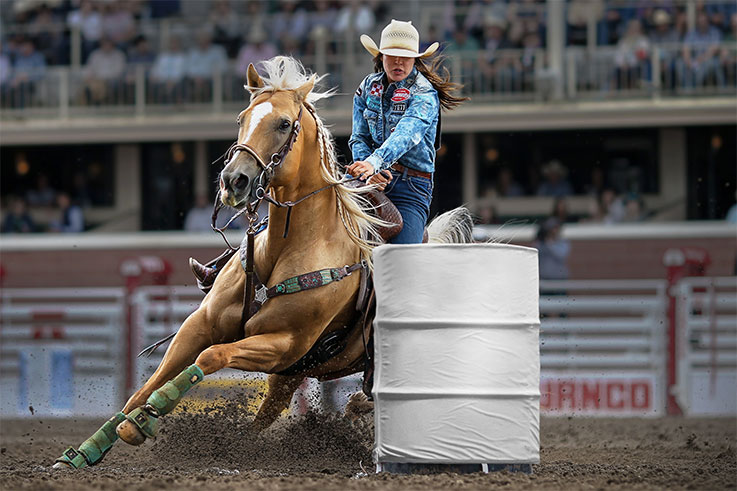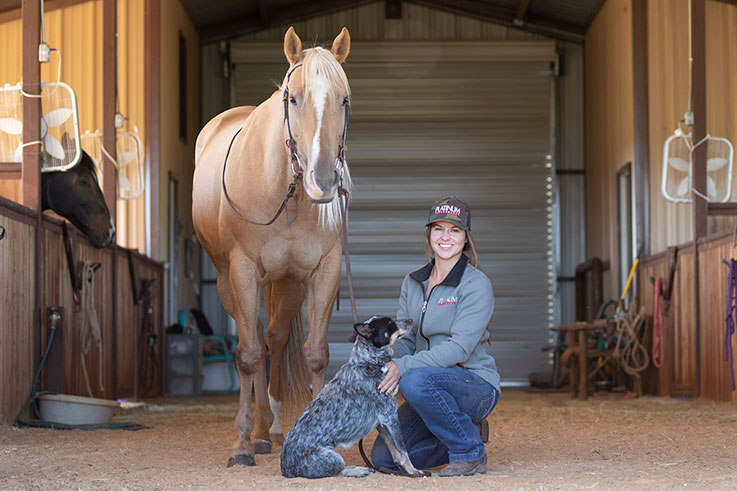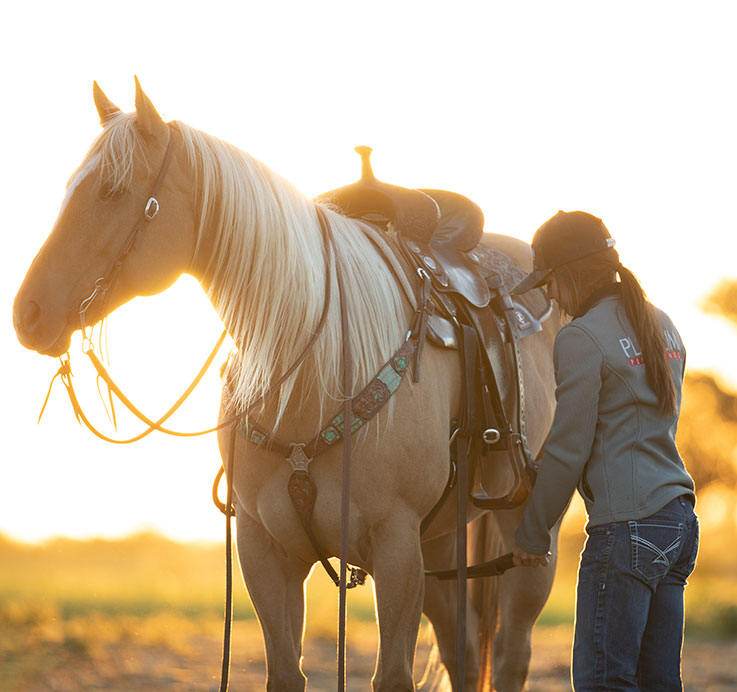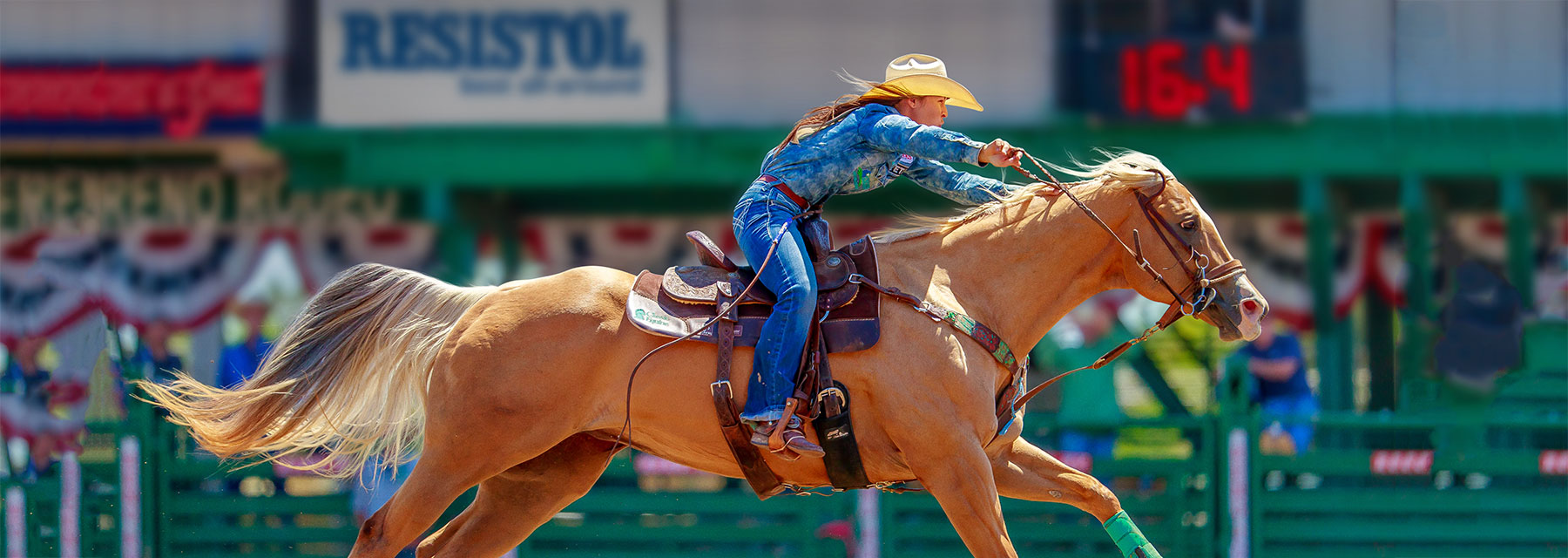How to Condition, School and Care for A Barrel Horse with World Champion Hailey Kinsel
For four-time Women’s Professional Rodeo (WPRA) World Champion barrel racer, Hailey Kinsel, winning happens when preparation meets talent. She wants her powerhouse yellow mare, Sister, who is the highest-earning Quarter Horse mare of all time with over $2.8 million in career earnings, in perfect condition when they enter the arena. “The biggest thing is I want her physically fit (lung, muscle and bone) before even considering going to a rodeo,” she says. This calls for detailed scheduling as she plans out what rodeos to attend. “I plan her exercise around every competition, so no run made is without a purpose. Everything's very strategic,” Kinsel explains. “There are some runs I'm making that are more about preparation for the next rodeo. Of course, you always want to win something, but a lot of times I'm making runs thinking ahead as to what the next rodeo is going to be like and how to best get her ready for that.”
Just like Kinsel’s rodeo schedule, Sister’s exercise program is purposely executed based on what their calendar looks like. “I plan out when I'm going to a rodeo and then work backward in terms of when I need her to be ready,” she says. “I want her to peak at the right time, both physically and mentally, so she’s working good and also craving it.” While the ultimate goal of winning rodeos stays the same, the preparation changes slightly based on the time of year. Each season comes with its own set of challenges that horses and riders must learn to navigate. While the fall and winter draw a limited number of small indoor venues, the spring and summer bring on a demanding schedule packed full of large outdoor courses. After competing on Sister for seven years, Kinsel knows how to tell when the mare is ready to hit the road. “I have a time threshold on how quick I want her to recover from interval training,” she explains. “We do three minutes walking, two minutes trotting, repeat that twice, and then lope for one minute with a two-minute walk in between each lead. If she does that with a very quick recovery time (after 30 seconds to a minute, she’s done breathing), then that's when I know lung-wise she’s in shape.” As far as bone and muscle condition is concerned, Kinsel relies on how Sister looks and feels in the saddle.
To keep her mare craving the sport, Kinsel keeps pattern work to a minimum and focuses more on practicing turning maneuvers without a barrel. “Before I go to a race, I am going to work the pattern at least one day but leading up to that, it is going to be a lot of dry work,” she explains. “It's more like strength training — working on the feel and the circles as a form of conditioning. I want to have that feel down, away from the barrels so that when I go to the pattern, it's very clear to me whether she's ready or not.” Depending on the rodeo that she’s prepping for, Kinsel may also focus her schooling on different aspects of the mare’s performance. For a smaller arena, she will school her on quickness in footwork and body shape while the bigger runs require focus on length of stride and reach around the turn. The type of arena footing also plays a role in how they can perform, and Kinsel prepares accordingly. On shallow ground, she wants her a little more squared up in the turn while deeper ground allows her to be much more round and fluent around the barrels. It’s this preparation that has helped Sister adapt to the variable conditions at any given rodeo and reach the winner’s circle time and time again.

DM Sissy Hayday, or Sister for short, is the highest-earning Quarter Horse mare of all time with over $2.8 million in career earnings. This 2011 palomino mare by PC Frenchmans Hayday has been Kinsel’s main mount since the duo won The American in 2017.
DM Sissy Hayday, or Sister for short, is the highest-earning Quarter Horse mare of all time with over $2.8 million in career earnings. This 2011 palomino mare by PC Frenchmans Hayday has been Kinsel’s main mount since the duo won The American in 2017.

“I plan out when I'm going to a rodeo and then work backward in terms of when I need her to be ready. I want her to peak at the right time, both physically and mentally, so she’s working good and also craving it.” —Hailey Kinsel
“I plan out when I'm going to a rodeo and then work backward in terms of when I need her to be ready. I want her to peak at the right time, both physically and mentally, so she’s working good and also craving it.” —Hailey Kinsel
Fueling a Champion
The quality, amount and timing of an athlete’s feeding regimen is important for success. Kinsel makes sure to feed Sister at least three hours before she runs. This can be especially important during night performances when her normal feeding time may fall right when she is scheduled to run. She says, “I may split up my feedings and give a smaller portion before the run so that when her time clock goes off for her normal feeding hour, her belly is already full and she doesn’t get a nervous stomach.” Then, once she’s finished making her run, she can get a second feeding to make up her entire meal. Kinsel also supplements daily with Platinum Performance® Equine, Platinum Balance™, Platinum Gastric Support, Healthy Weight and Platinum Joint Care Competition + HA. While she’s traveling, she increases Platinum Gastric Support to two scoops per day to support her hindgut health out on the road.
Kinsel's Travel Tip
“I learned several years ago that any time you stop your truck and trailer, you should offer your horses water. It creates a habit that when the trailer stops, they get water. That way if you have young horses that don’t always drink, it teaches them over time that when this vehicle stops, water will be offered.”
Contestant Parking Ahead

While all contestants deal with the nervous emotions of competing differently, Kinsel finds comfort in making sure she has the best set up for her equine partner. “Sister’s parking preference is wherever it's soft, wherever there's water and wherever she can see the arena,” she jokes. “I wish I was kidding! She really likes to watch the performance and see what’s going on.” Once tacked up, Kinsel will get on about 40 minutes before her planned run to warm up and get Sister focused. “She knows when we leave the trailer, she has a couple minutes to look around and then we're working,” she says. Like any good horseman, her warm-up fluctuates depending on how her mare feels but for the most part, it will be made up of about 10-15 minutes of trotting, loping and doing flexions while the rest of the time will be spent walking. “I don’t have a routine for her. For some horses, a routine keeps them calm, but she’s kind of the opposite,” she says. “It’s better to keep her guessing a little bit, so she’s listening to me. I kind of just take the liberty of doing whatever I feel she needs that day, and I don't question it.” Kinsel does admit to having a couple quirky rituals that keep her from getting nervous before their runs. She says, “When I get off to pull my girth, I will loosen it and then go around and check everything, take up my reins, then once I tighten it back up, I always get on the right side (opposite side). I don't know why, it's just like I feel very ready then.” As it starts to get close to go-time, Kinsel makes sure she is ready early for when they call her name. “Two girls before me is when I pull my hat down. Things just go pretty fast. The girl ahead of me may turn out, and the judge is expecting me to be ready when he calls my name, so I always make sure I’m ready two before me,” she says. And once they call her name, Sister is off to smoke another fast run through the barrel pattern.
“I learned a long time ago from a racehorse guy that the after run care is not only something that gets forgotten, but it's something that your horse is going to remember the next time you go to make a run.”
— Hailey Kinsel, 4-time WPRA World Champion Barrel Racer, Champion of The American, WNFR Arena Record Holder and Platinum client since 2016
The Cool Down Period
The most important part of Kinsel’s routine is her post run care. She explains, “I learned a long time ago from a racehorse guy that the after run care is not only something that gets forgotten, but it's something that your horse is going to remember the next time you go to make a run.” While horses may not recall their last race, they will remember how they felt physically post-run and how they were taken care of or rewarded for their hard work. “I have a pretty decent 30-minute cool out routine,” Kinsel says. “I'm going to get off and pull her girth, preferably at the back of the alley or wherever the excitement just happened. Then, I’m going to walk out for about 10 minutes.” During this time, she will head back to the trailer, put Sister’s halter on and remove her protective boots and saddle. She goes on, “Of course water is the first thing I'll offer when I get back to the trailer because sometimes when she's the most worked up is when she wants to drink.” Kinsel will keep water in front of her for the next few hours to ensure she hydrates herself adequately. Once the mare has drank and her breathing is back to normal, Kinsel will spray her legs off with cold water or use ice boots if there’s no water available. Kinsel concludes, “When she's quiet, I'll give her cookies and put either a poultice or cold alcohol on her legs to keep them cold and tight.”
With all of this articulate planning and detailed care, it’s no wonder that Hailey Kinsel and Sister have been unstoppable for nearly a decade. Kinsel has found the ultimate routine to keep her speedy palomino at the top of their game and she has no plans of slowing down anytime soon. As we watch this duo light the rodeo trail on fire this Cowboy Christmas, just remember all the planning, care and conditioning that has gone into making this team a success.

